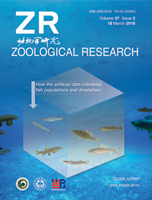
|
Zoological Research
Kunming Institute of Zoology, Chinese Academy of Sciences
ISSN: 2095-8137
Vol. 33, No. 4, 2012, pp. 343-353
|
 Bioline Code: zr12052
Bioline Code: zr12052
Full paper language: English
Document type: Research Article
Document available free of charge
|
|
|
Zoological Research, Vol. 33, No. 4, 2012, pp. 343-353
| en |
Geographic patterns and ecological factors correlates of snake species richness in China
CAI, Bo; HUANG, Yong; CHEN, Yue-Ying; HU, Jun-Hua; GUO, Xian-Guang & WANG, Yue-Zhao
Abstract
Understanding large-scale geographic patterns of species richness as well its underlying mechanisms are
among the most significant objectives of macroecology and biogeography. The ecological hypothesis is one of the most
accepted explanations of this mechanism. Here, we studied the geographic patterns of snakes and investigated the
relationships between species richness and ecological factors in China at a spatial resolution of 100 km×100 km. We
obtained the eigenvector-based spatial filters by Principal Coordinates Neighbor Matrices, and then analyzed ecological
factors by multiple regression analysis. The results indicated several things: (1) species richness of snakes showed
multi-peak patterns along both the latitudinal and longitudinal gradient. The areas of highest richness of snake are tropics
and subtropical areas of Oriental realm in China while the areas of lowest richness are Qinghai-Tibet Plateau, the
grasslands and deserts in northern China, Yangtze-Huai Plain, Two-lake Plain, and the Poyang-lake Plain; (2) results of
multiple regression analysis explained a total of 56.5% variance in snake richness. Among ecological factors used to
explore the species richness patterns, we found the best factors were the normalized difference vegetation index,
precipitation in the coldest quarter and temperature annual range ; (3) our results indicated that the model based on the
significant variables that (P<0.05) uses a combination of normalized difference vegetation index, precipitation of coldest
quarterand temperature annual range is the most parsimonious model for explaining the mechanism of snake richness in
China. This finding demonstrates that different ecological factors work together to affect the geographic distribution of snakes in China. Studying the mechanisms that underlie these geographic patterns are complex, so we must carefully
consider the choice of impact-factors and the influence of human activities.
Keywords
Macroecology; Ecological hypothesis; Biogeography; Spatial distribution patterns; Energy hypothesis; Habitat heterogeneity hypothesis
|
| |
© Copyright 2012 - Kunming Institute of Zoology, the Chinese Academy of Sciences
Alternative site location: http://www.zoores.ac.cn/
|
|
